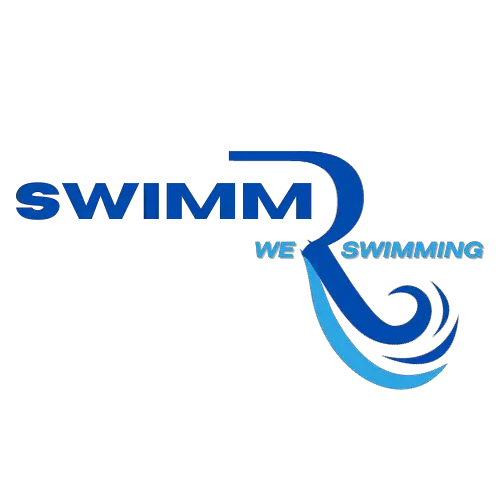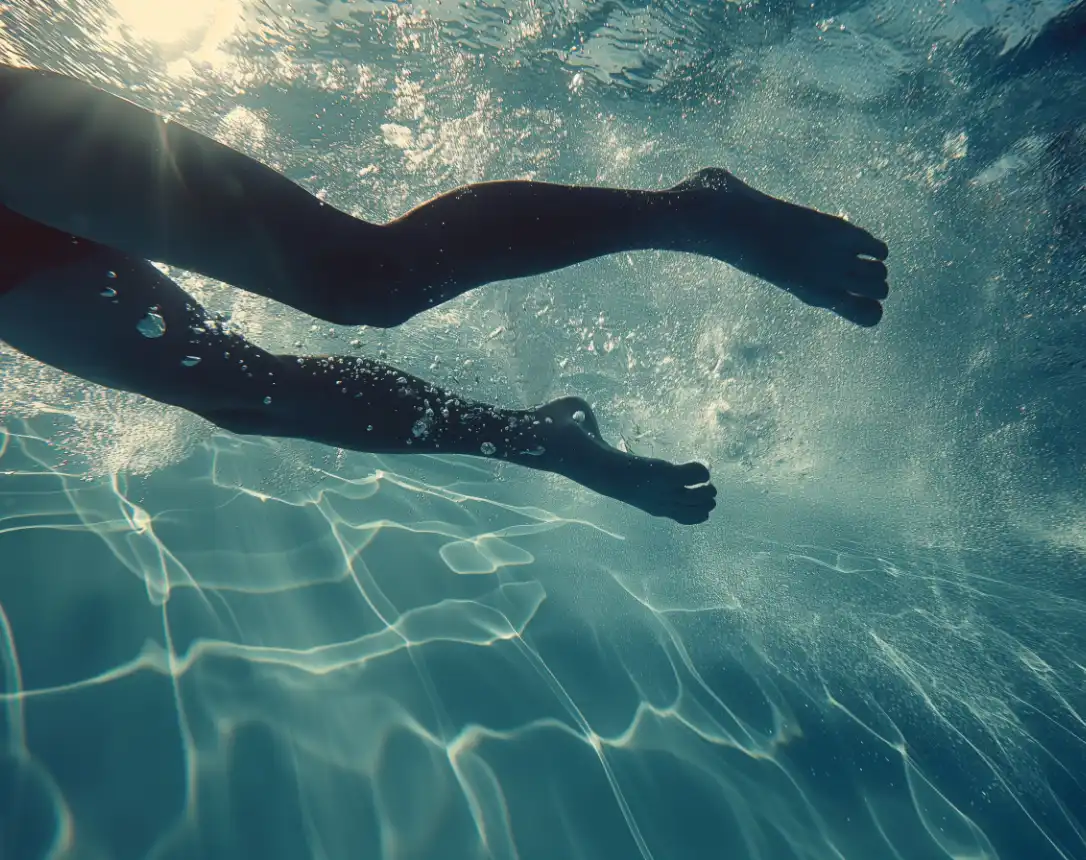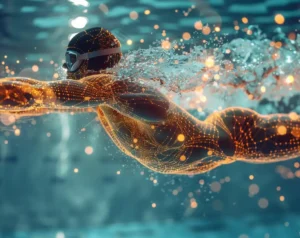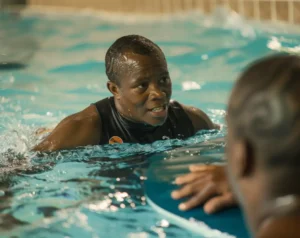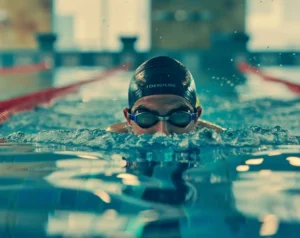Embark on a journey to unlock the power of your legs in swimming, a crucial yet often underrated aspect of the sport. Whether you’re propelling through the water with a powerful kick in freestyle or mastering the rhythmic motion of the butterfly, understanding how to effectively use your legs can transform your swimming performance. From enhancing speed to improving endurance, let’s dive into the techniques that will make your legs your greatest asset in the water.
Fundamentals of Swimming
I’ve always been fascinated by the power and grace of swimming. It’s not just about splashing around; every movement is a complex interaction between the body and water. As an avid swimmer, I’m excited to break down how our lower limbs play a critical role in this dynamic sport.
Importance of Legs
Kicking is to swimming what rhythm is to music—it’s foundational. In all strokes, a well-executed kick does more than move you forward; it stabilizes your body position, contributing to a streamlined form. Here’s how legs fuel your swim:
- Propulsion: Each kick generates force, propelling you through the water. It’s all about the combined actions of the feet and legs, whether it’s the flutter kick in freestyle and backstroke or the whip kick in breaststroke.
- Muscle Engagement: Your legs are powerhouses, filled with muscles that demand engagement. When you swim, your quadriceps, hamstrings, calves, and glutes work in harmony, converting strength into speed.
- Hip Rotation: In freestyle and backstroke, the legs aren’t just kicking; they’re part of a full-body motion. The hips play a starring role, rotating in sync with your strokes for maximum efficiency.
Mastering leg techniques in swimming can feel as complex as a dance, but it’s exhilarating. Think of the sensation when your kick is so spot-on that every movement is effortless, and you’re slicing through the water like a blade—there’s nothing quite like it.
Leg Techniques and Movement
In the thrilling world of swimming, mastering leg techniques is a game-changer. I can’t emphasize enough how a swimmer’s success hinges on their kick’s power and efficiency. Let’s dive into the specifics of each stroke’s kick, and see how fine-tuning our leg movements can propel us through the water like a torpedo!
Freestyle Kick
The freestyle kick, or flutter kick, is my bread and butter. It’s a rapid, alternating motion that originates from the hips. My legs are straight but relaxed, the toes pointed, creating propulsion with every beat. The movement is consistent and should be:
- Continuous: No pausing between kicks.
- Controlled: Kicks are narrow, without excessive splash.
Breaststroke Kick
The breaststroke kick, sometimes likened to a frog’s movements, demands precise technique.
- Bend the knees: Legs are drawn up towards the body.
- Turn the feet out: Toes point outward to catch the water.
- Kick back and together: Push water backwards with the soles, snapping legs closed for a powerful thrust.
Backstroke Kick
Here, the flutter kick lights up the show again, but with me on my back. The sky’s the limit when it comes to how crucial it is that my legs kick with steady rhythm, remaining just below the water surface to:
- Minimize drag
- Maximize speed
Butterfly Kick
And finally, the dolphin kick steals my heart in the butterfly. My legs are pressed together moving in a wave-like motion. It’s all about the hips – where the magic happens! The kick is a harmonious, undulating movement that powers from the core and transfers through the legs:
- Concise undulation: Both legs move as a single unit.
- Power through the hips: The impulse starts at the hip, not the knees.
Swimming with efficient leg techniques gives me an edge, transforming each stroke into a seamless blend of power and elegance. With a solid leg kick and a trusty kickboard for drills, I maximize my training and watch as the seconds tick off the clock. Now, it’s your turn to amp up your game!
Strength and Conditioning
When I think about excelling in swimming, I focus not only on the time I spend slicing through the water but also on the vital role of strength and conditioning. It’s the powerhouse driving each stroke, propelling me forward with more speed and less fatigue. Let’s jump into the workouts that amplify leg power and enhance in-pool performance!
Dryland Exercises
Squats with Dumbbells:
- Target: Quads, hamstrings, glutes
- How: Stand with feet shoulder-width, holding dumbbells at your sides. Squat while keeping your chest up and back straight. Power through your heels to rise.
Romanian Deadlift:
- Target: Hamstrings, lower back
- How: Hold dumbbells in front of you, hinge at hips, keeping legs straight. Lower the weights close to your legs, then squeeze your glutes to return to standing.
Lateral Lunge:
- Target: Glutes, quads, inner thigh
- How: From standing, step right into a deep side lunge, dumbbells in hand. Push back to center and repeat on the other side.
In-Pool Drills
Flutter Kick Drill:
- Focus: Ankle flexibility, leg power
- How: Grab a kickboard and perform flutter kicks. Ensure your kicks are small and rapid, originating from the hips with straight yet relaxed ankles.
Dolphin Kick Drill:
- Focus: Core, glutes, ankle flexibility
- How: Without a board, practice dolphin kicks. Your legs should work as one unit, driven by your core and glute muscles, moving in a wave-like motion.
Adopting these exercises into my routine is a game-changer. They keep my legs conditioned, ensuring I am competition-ready. Each drill translates directly into stronger, more precise kicks in the pool—totally exhilarating!
Technique Refinement
I always say that refining your technique can transform a good swimmer into a great one! We’re going to talk about breath control and body coordination, the two components I find most crucial in the pursuit of swimming efficiency. Let’s dive into how these aspects can sharpen your performance in the water.
Breath Control
Breath control is the keystone of my swim sessions. It’s not just about the frequency of your breathing, but also the technique. I begin with a focus on breath timing. It’s essential to exhale steadily underwater so you’re ready to inhale quickly during the turn of your head. Here’s a tip: practice exhalation in a relaxed manner to avoid a build-up of carbon dioxide, which often leads to panic and premature exhaustion. Imagine your lungs as balloons; even distribution of air release is key.
| Components | Tips |
|---|---|
| Inhalation | Quick and sharp at the head turn |
| Exhalation | Steady and continuous underwater |
| Rhythm | Develop a consistent breathing tempo |
Body Coordination
On to my next point: body coordination. This means syncing your leg kicks with the movements of your upper body to maintain a streamlined position. It’s about the integration of your arms’ catch phase with the body movement and balance. A well-coordinated stroke starts with a strong core, ensuring that your body moves as one fluid entity. Remember not to let your legs just drag; they need to be active contributors to your forward momentum. It might be helpful to visualize your body moving through the water like a powerful but graceful fish.
- Body Rotation: Engage your core to rotate smoothly from side to side.
- Arm and Leg Coordination: Time your kicks with the arm strokes for optimal propulsion.
- Technique Tips: Use drills to isolate and then integrate each movement for more effective coordination.
Advanced Swimming Strategies
When I hit the water, everything shifts — power, agility, and technique fuse in an intricate dance of speed. Crafting a perfect stroke hinges on mastering each phase of the swim, from the initial catch to the explosive push-offs. Let me guide you through the nuances of advanced swimming strategies that can shave seconds off your time and make every kick count.
The Catch Phase
I’ve learned that the catch phase is crucial for a stroke’s efficiency. It’s the part where my hand first enters the water and starts pulling back. To maximize efficiency, I focus on keeping my elbow high and hand pitched at just the right angle to catch as much water as possible. This sets up a strong propulsive kick, ensuring each stroke propels me forward with power.
- Keep elbow high
- Angle hand for maximum water catch
- Coordinate with propulsive kick
Underwater Dolphin Kicking
The transformative power of underwater dolphin kicking never ceases to amaze me. It’s that undulating move that comes into play after the push-offs and starts, right before I break the surface. I maintain a tight streamline position to minimize drag, using my entire body in a whip-like motion. This technique bolsters my underwater phase, often termed the ‘fifth stroke,’ due to its potential in giving a competitive edge.
- Streamline position to reduce drag
- Undulating whole-body motion
- Competitive edge as a ‘fifth stroke’
Sprint Kicks
Sprint kicks are the turbo boost in my swimming arsenal. In shorter distances, I ramp up the kick frequency for hefty bursts of speed. My legs become a powerhouse during sprints, supplying a steady, propulsive force that complements the high-tempo arm strokes. Balancing energy expenditure is key; I’ve got to channel my strength into effective bursts without tiring out too quickly.
- Increase kick frequency for speed bursts
- Balance energy for effectiveness
- Sustain propulsive force in harmony with arm strokes
Equipment and Training Tools
I’ve discovered that the right gear can make a huge difference in swimming training! Let’s dive into some must-have equipment that’ll supercharge your leg workout in the pool.
Fins and Kickboards
Fins, also known as flippers, are fantastic for strengthening the leg muscles and improving your kick technique. I’m a big fan of Zoomers Fit Fins; they’re shorter than traditional fins, which means they really help in creating that quick, propulsive motion similar to race-pace kicking. It’s thrilling to feel that surge of speed when I power through the water with them on!
A kickboard is as essential as the chlorine in the pool. It allows me to focus strictly on my legs, isolating the kick and honing in on technique. Plus, it’s an excellent tool for endurance sets. My kickboard has been my trusty sidekick, especially during those grueling kick sets.
By pairing fins and a kickboard, my workouts gain an extra layer of resistance. This combination not only boosts my strength and stamina but also keeps my training exciting. I always ensure my kickboard is within reach poolside, ready for those leg-intensive drills. With this dynamic duo, every kick feels like a step closer to my personal best!
Swimming for Different Age Groups
When I first plunged into the pool, the importance of legwork in swimming hit me like a wave. Whether I’m kicking to keep afloat or propelling myself through the water, the strength and technique of my leg movements are crucial. This section will explore the role legs play in swim workouts across different age groups.
Swimming for Beginners
For those dipping their toes in the water for the first time, starting with the basics is essential. A beginner’s legwork is focused on developing comfort and coordination. Swim workouts for beginners typically involve:
- Flutter Kicking: A foundational skill for maintaining balance and propulsion.
- Board Drills: Holding a kickboard while practicing kicks helps establish a rhythm and strengthens leg muscles.
Masters Swimming
Masters swimming offers a platform for competitive swimmers above the age of 25. Here, the role of legs evolves:
- Refined Technique: The emphasis is on perfecting the kick to minimize drag and maximize speed.
- Endurance Training: Swimmers engage in more complex workouts, such as interval kicking sets with fins, for enhanced endurance.
Swimming for Adults
Swimming for adults is a mix of fitness and leisure, where legwork serves dual purposes:
- Health and Fitness: Adult swim workouts often include leg-based exercises aimed at cardiovascular health and muscle toning.
- Recreational Activity: Those swimming simply for enjoyment still benefit from strong leg movements to improve their comfort and safety in the water.
Masters swimmers or those who have been out of the water for a while can revisit their fundamental leg techniques to regain or enhance their form.
Injury Prevention and Recovery
Before you take the plunge, I want to highlight the essentials of preventing injuries and facilitating recovery in the world of swimming. Getting excited about swimming is natural, but let’s not forget – our legs are pivotal. Ensuring they’re ready for action means less time on the sidelines and more in the lane. From my own experience, two key elements stand out: a solid warm-up routine and effective stretching techniques.
Warm-Up Routines
1. Dynamic Movements:
- Leg swings: Aim for 20 per leg to wake up those hamstrings.
- Ankle rotations: Do two sets of 15 to keep ankles flexible.
2. Low-Intensity Swimming:
- Before going full throttle, swim a few easy laps to gradually increase heart rate and muscle temperature.
Stretching Techniques
Hamstring and Lower Back Stretches:
- Forward fold: Hold for 30 seconds; it eases tension in the lower back and stretches the hamstrings.
- Cat-Cow Pose: Transition between arching and rounding your back for one minute to improve lower back flexibility.
Ankle Flexibility:
- Seated ankle stretches with a band: Perform 3 sets of 10 reps to strengthen and stretch ankle joints.
I’ve found staying consistent with warm-ups and stretches drastically cuts down injury risk while swimming. Remember, prevention is your first stroke towards recovery. Keep those legs limber, and you’ll be powering through the water like a pro.
FAQ – Frequently Asked Questions
How important are legs in swimming?
Legs provide propulsion, balance, and speed, making them essential for efficient swimming across all strokes.
What exercises strengthen swimming legs?
Squats, lunges, and calf raises off the pool, plus flutter and dolphin kicks in the water, build leg strength.
How can I improve my kick technique?
Focus on flexibility, ankle strength, and practicing kick drills with and without a kickboard to refine your technique.
Thanks for exploring the critical role of legs in swimming with us. Your experiences and insights are invaluable, so please share them in the comments or on our social media platforms like Instagram and Pinterest. Together, let’s kick our way to success!
